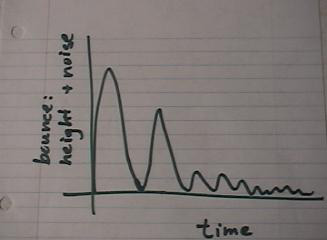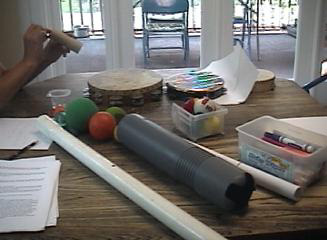
Setup: The materials for the project are assembled on the work surface.
First I tapped all of the tambourines with my fingers. The big tambourine had a low pitch, the small one haad a high pitch and the medium one had a high pitch and the metal discs jingled. Next I hit each tambourine by flicking it with my finger. Same results.
I picked up a marble and dropped it onto each. It did not bounce equally on the tambourines. I experimented with bouncing the marble in the center of each tambourine.
The marble bounced best on the small tambourine and least on the big tambourine. Then I bounced the marble on the edge of the tambourines. Both the medium and big tambourines had better bounces at the edge. The bounce was the same in the middle and at the edge of the small tambourine.
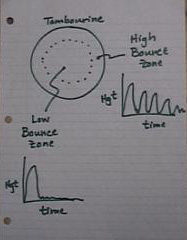
I changed from a marble to a 2" superball. The superball bounced in the same pattern on all the tambourines. It had a big initial bounce. The bounce diminished rapidly until the ball just rolled off the tambourine.
I switched to a hollow, hard plastic ball. The bounce was damped earlier on the large tambourine.
Next, I closed my eyes and compared the noise produced when bouncing the superball and the hard plastic ball on the drums. The pattern was the same, but the tone of the sound was different. You could definitely tell which was the solid ball and which was the hollow ball.
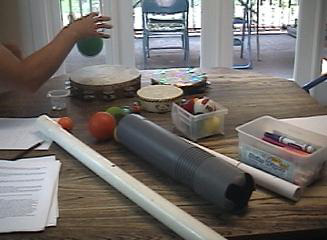
Nerf ball: bouncing a Nerf ball on one of the tambourines
ball had a nice bounce. I put it in a "keeper" pile.
Next I tried bouncing two balls at a time. They kept hitting each other and bouncing off the table, so I stopped that.
Toilet tube launch: Using the toilet paper tube as the launch tube.
Next I picked up the toilet paper tube and a marble. I launched two or three marbles. I noticed they bounced off the first drum and keeping going forward. This gave me the idea to line the drums up. I launched a few more marbles. The marbles rolled off the table.
I decided to put up a baffle. I grabbed to pieces of paper and propped them up behind the second tambourine. I used the third (small) tambourine as the prop. By shifting the paper baffle I was able to get the marbles to roll back in my direction.
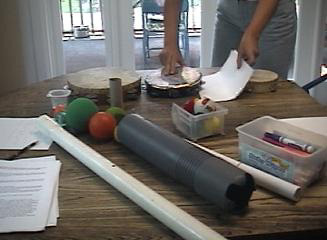
Backboard: Using the scrap paper to create a baffle. The baffle is designed to prevent marbles from falling onto the floor.They still kept rolling to the side, so I grabbed the PVC pipe and angled it from the baffle to me. Then, by aiming the marbles carefully, I could get them to bounce on each tambourine, onto the baffle and then roll along the PCV pipe and back to me.
Adding return tube: The PVC pipe being added to the set up.
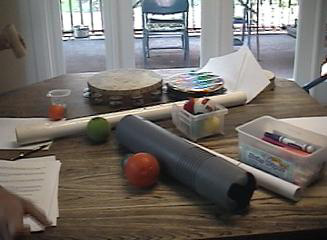
New setup: The PVC pipe is in place and the marbles should return to the launch area.
I varied the angle and height of the tube to see which returned the marble at a higher velocity. When I set the tube up high (high potential energy), the marble would bounce over the paper and off the table. I wondered if a longer tube would give the marble a better "running start", so I switched to the rolled up paper tube. It was about 14" long. I could get the marbles to bounce higher by holding this tube at a shallower angle.

Paper roll launch: Using the rolled paper tube as the launch tube.
I switched to the wooden bead and compared its bounce to that of the marble. Using both the short and long launch tube, the bead bounced over the paper and onto the floor.
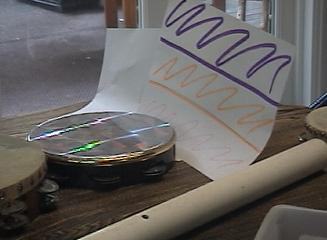
Scoreboard: A close up of the scoreboard that was added.
Next, I made a target by coloring three bands of color across a sheet of paper. I set it up behind the second drum. By adjusting the angle and height of the tube, I could "measure" how the bounce was affected.
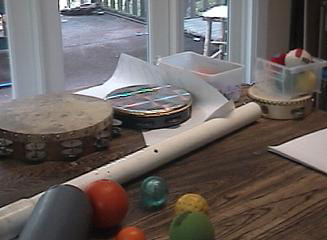
Basket: The scoreboard has been removed and the pencil basket was added after the paper baffle.
I was tired of picking marbles up off the floor, so I decided to put the pencil basket behind the paper baffle. I removed the target and decided to try launching marbles in an attempt to make baskets. This was fun! I repeated it a lot and made many baskets. Eventually I tried to pour all the marbles down the tube, but they spilled all over. I laughed and picked them all up.
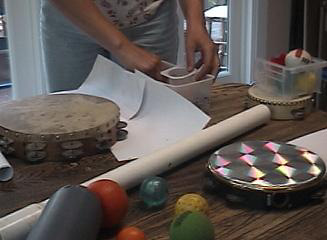
Smaller basket: Once I got good at aiming the marbles, I wanted a more challenging target. Here I'm adding a small plastic yogurt cup into the pencil basket.
I was getting good at making baskets, so I decided I needed a more challenging target. I got a small plastic yogurt cup and set it in the pencil basket. I practiced making baskets. Out of eleven shots, I made 4 baskets in the little cup.
